6 Chapter 6: Dutch Masters and the Birth of the Modern Art Market
Learning Objectives ~ Chapter 6 “Dutch Masters and the Birth of the Modern Art Market”
- Describe the impact of Protestantism in the visual arts
- Examine how the modern art market rose to commercial success in the Protestant north
- Consider the ways that the ‘new science’ and artistic expression melded
This chapter features an overview of a few genres of northern Baroque, or Dutch, painting. Dutch domestic genre paintings, portraiture and still life are categories of secular art that come into popularity in the Protestant north.
It’s important to note that Calvinism is the embraced denomination of Protestantism in parts of northern Europe. The main tenets of this faith are predestination (the belief that your life is already plotted out by an all-knowing God, your salvation is as well. Calvin maintained that one demonstrates one’s favor in God’s eyes via hard work and a serious work ethic. The notion “To work is to pray” is Calvinist. This is crucial to understanding Calvinism because he promoted the idea that successful people were obviously more in the favor of God’s eyes. This led to a rather ruthless view of the poor. They are people you would help, certainly, but there is a limit. To Calvin, you show your adoration of God by working very hard and being successful.
And then ironically he opposed ornamentation as a kind of vanity. As far as art goes, he was okay with it so long as it served a didactic purpose. Art that is productive, in a sense. It teaches something.
The Dutch Reformed Church: Architecturally, ‘strict doctrine and whitewashed spaces’ …
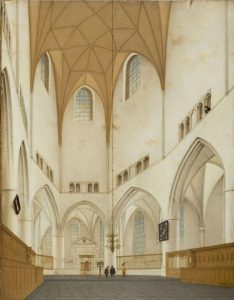
(Pieter Saenredam, Interior or the Choir of Saint Bavo’s in Haarlem. 1660.)
Calvinism, like most protestant factions, believed that individual prayer and meditation were crucial. Thus these empty spaces and white walls invited contemplation. A stark contrast to the Baroque churches of the Catholic south!
Jan Steen
Jan Steen was a successful Dutch painter. In his self portrait, you see a confident and sincere gaze… and a focus on the artist’s hands:
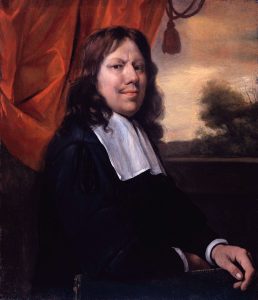
But I wanted to show you his work as an example of didacticism in art.
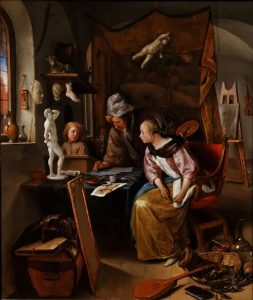
His “The Drawing Lesson” is a genre scene. And it seems pretty harmless and benign. But Dutch art invites you in… because there’s so much going on! In this a young girl is working with her male tutor. The chaperone is… her little brother? That’s all? Hmmmm…this is rather risqué. Are we concerned that she is looking at a male nude statue and that a cupid form is floating above?
Steen’s “Burgher of Delft” is a typical portrait. A wealthy burgher, merchant, dressed modestly as is his daughter, magnanimously considering giving alms to the poor.
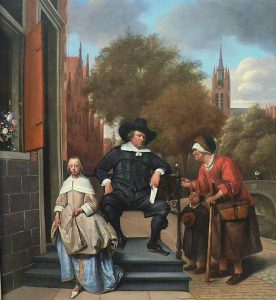
But Steen’s “The world turned upside down” is an example of didacticism. The focal point of this painting is the face of the woman. She seems inebriated, loose, slatternly. She is tickling the thigh of the drunken rogue sitting next to her. All around them is weird stuff. A duck on a shoulder, a basket of stuff suspended and about to fall, a pig coming in, trash on the floor, a sleeping nanny, kids getting into stuff. Chaos. The world turned upside down. Why? How? Well, what takes center stage? A woman who has lost her decorum and respectability. The lesson? Morality resides in women… and when they let that go. Voila! This is what happens.
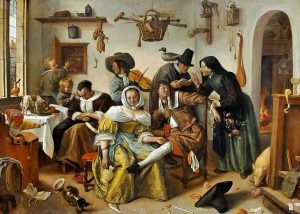
Jan Vermeer
Jan Vermeer is another artist worth taking a quick look at. His View of Delft demonstrates that fascination with landscape (Dutch landschap which meant landform). Vermeer worked very slowly and in plein air. He worked in ‘real light’ either outside or in. This view of Delft, a major port in the 17th century, shows attention to detail and atmosphere. The quality of blue that is the sky and the way he captured the moisture in the clouds. The water mirroring this activity.
Vermeer created merely 40 works in his time. He took his time. A master of capturing all facets of light. The Girl with a Pearl Earring.
Women were a favorite subject. Whether reading letters, drinking wine, doing embroidery, dressing. We also see his love of scientific gadgetry. Scales, globes, measuring devices, maps…. Please listen to this analysis of Woman Holding a Balance:
Rembrandt
Rembrandt is undoubtedly a name that comes to mind when one thinks of Dutch art of the Baroque period. He was a painter, an etcher and a draughtsman. He lived from 1606-1669, most of his life spent in Amsterdam. His early years he worked under several different tutors but the turning point for his development as an artist came when he spent about 6 months working with Pieter Lastman. From that time he worked toward his very distinct treatment of his subject matter, with exaggerated gestures, naturalistic expression, unique lighting effects and glossiness.
He loved biblical subject matter and this work, The Stoning of St Stephen from 1625, is one of his first most important works because in this you can see how he conceptualized the composition of the work in a way that was very different. Layered, really. And has wildly gesturing people, captures the horror and chaos of the stoning, and uses a light/dark contrast that suggests a polarity. On the left of the work you can see the figure of Saul of Tarsus, who ordered the stoning and he is barely recognizable in the ‘shadow’ of his sin… and in the light you see the heinous crime. The light might suggest a kind of beauty and righteousness in this martyrdom. And what adds an interesting twist to this is that Saul eventually converts to Christianity and becomes one of its most ardent defenders.
Much of Rembrandt’s early work was portraiture. Wealthy patrons and people of renown or reputation that used portraiture as a symbol of success and respectability.
Please watch my lecture: Rembrandt
Marie van Oosterwyck
Marie van Oosterwyck was one of the most talented of Holland’s female artists, or really any I should say. Drawing on the tradition of realism and naturalism she infused her work with minute detail. Her Vanitas is a good example. Vanitas is a genre of its own. It literally means “vanities” and refers to all the things we put our minds and effort to that are transitory. They’re a lot of fun, but they are fleeting. They take our minds away from the harder work…. Spiritual work. And meanwhile, time ticks away. All these things represent fleeting pleasures and interests. The skull, the moth, the money, the books, science, the half eaten corn, the half drunk wine and even the flowers are dying. The hourglass reminds us that time is ticking… set your mind to what matters, the salvation of your soul. It’s so protestant. Really.
Dutch Still Life
Please listen to two art historians doing a visual analysis of Jan van Huysum’s Vase with Flowers:
I also love the food of Dutch still life. Scrumptious, luscious, expensive, gorgeous yummy exotic foods. It was common to these sorts of paintings in dining rooms, the images accompanying daily feasts and representing abundance. Another common element that appeared in Dutch still life paintings was tulips. Tulips were highly prized. They were exotic imports from Turkey and it was discovered that the types could be tampered with and made into amazing specimens. But again, tulips are one flower that get more beautiful as they start dying. And nearly dead tulips were often put into still life.
Beautiful, yes. Symbolic, yes. Didactic, yes. That is Dutch art.

